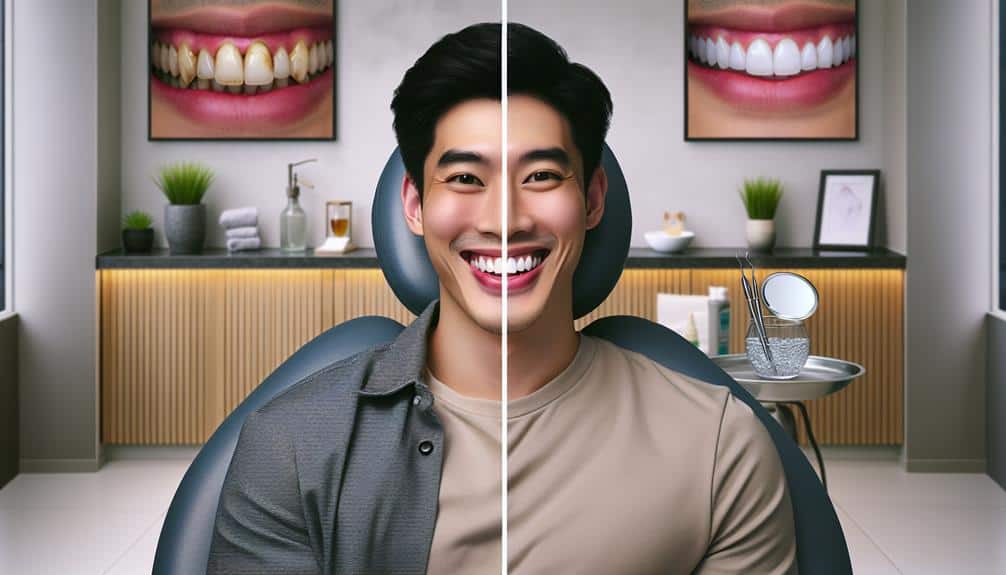To guarantee wine stains for whiter teeth: blot the stain, apply a mix of vinegar and water, then rinse. For white wine stains, rinse mouth with water and use whitening toothpaste with baking soda. Try hydrogen peroxide and water mouthwash or seek professional cleaning. Prevent stains by using a straw, oil pulling, and fabric protection sprays. Whiten naturally with coconut oil or apple cider vinegar. Apply a paste of baking soda and hydrogen peroxide. Use charcoal products or strawberry paste for stain removal. These tips secure a brighter smile and confident look.
Key Points
- Rinse mouth with water post white wine to dilute acidity.
- Use whitening toothpaste with baking soda for teeth cleaning.
- Employ hydrogen peroxide and water mix as mouthwash.
- Consider professional dental cleanings for stubborn white wine stains.
- Implement oil pulling for natural teeth whitening benefits.
Red Wine Stain Removal Methods
When tackling red wine stains, consider using white vinegar as a natural and effective solution for removal. White vinegar works by breaking down the red wine pigments, making it easier to lift the stain from the fabric. To start, blot the stain with a clean cloth to absorb as much of the wine as possible. Then, mix one part white vinegar with two parts water and apply it to the stain. Let it sit for 10-15 minutes before rinsing with cold water. Repeat this process until the stain lightens or disappears completely.
For stubborn stains, you can create a paste using white vinegar and baking soda. Apply the paste to the stain, gently scrub it in, and let it sit for about 30 minutes before rinsing. This method is particularly effective for coffee stain removal as well.
To prevent tea stains, consider adding a splash of white vinegar to your laundry when washing tea-stained items. White vinegar not only helps in stain removal but also acts as a natural fabric softener.
White Wine Stain Removal Techniques
To tackle white wine stains effectively, consider utilizing specific methods tailored to the removal of these particular stains. White wine stains may be less pigmented than red wine stains, but they can still pose a challenge. For immediate action, rinse your mouth with water to dilute the wine's acidity and prevent it from setting into your teeth.
Follow up by brushing your teeth with a whitening toothpaste that contains baking soda to help lift the stains. Another effective technique is to use a mixture of hydrogen peroxide and water as a mouthwash, swishing it around for a minute before spitting it out. This helps to break down the stains and brighten your teeth. If the stains persist, consider seeking professional dental cleaning services.
While white wine stains can be stubborn, with the right approach, you can effectively remove them and restore the whiteness of your teeth. Remember, prevention is key, so be mindful of your consumption and consider using a straw when drinking to minimize direct contact with your teeth.
Baking Soda and Hydrogen Peroxide
When dealing with tough wine stains, consider utilizing the powerful combination of baking soda and hydrogen peroxide.
This dynamic duo isn't only gentle on fabrics but also highly effective in lifting and whitening stubborn wine stains.
The bubbling action of hydrogen peroxide paired with the abrasive texture of baking soda creates a potent stain-fighting solution.
Whitening Power Duo
Enhance your wine stain removal arsenal with the powerful Whitening Power Duo of Baking Soda and Hydrogen Peroxide.
This dynamic duo is a go-to solution for achieving whiter teeth by effectively removing stains caused by red wine. Baking soda, with its mild abrasiveness, works to gently scrub away surface stains, while hydrogen peroxide acts as a bleaching agent, targeting deep-set discoloration.
To create a paste, mix a small amount of baking soda with a few drops of hydrogen peroxide until it forms a thick consistency. Use this paste to brush your teeth for about 1-2 minutes, then rinse thoroughly.
Gentle and Effective
For a gentle and effective wine stain removal solution, consider utilizing the powerful combination of Baking Soda and Hydrogen Peroxide. These ingredients are commonly found in toothpaste alternatives and DIY whitening treatments, making them ideal for removing stubborn wine stains from your teeth.
To create this stain-fighting mixture, mix a small amount of baking soda with hydrogen peroxide to form a paste. Gently brush this paste onto your teeth, focusing on the areas affected by the wine stains. The mild abrasiveness of the baking soda helps scrub away surface stains, while the hydrogen peroxide acts as a bleaching agent to whiten your teeth.
Use this remedy sparingly to avoid damaging your tooth enamel, and always rinse thoroughly after use for a brighter, stain-free smile.
Activated Charcoal for Stain Removal
Activated charcoal is a versatile substance known for its ability to effectively lift stains from various surfaces.
You can apply activated charcoal in different ways to tackle wine stains, such as creating a paste or using activated charcoal powder.
After using activated charcoal, you can expect to see noticeable results in the reduction or complete removal of wine stains on fabrics and other materials.
Charcoal Benefits for Stains
Discover the powerful stain-fighting properties of charcoal, a natural remedy renowned for its effectiveness in removing tough stains. Charcoal is a potent ally in achieving a brighter smile. Here are some benefits of using charcoal for stain removal:
- Natural Whitening: Charcoal toothpaste can help whiten teeth by removing surface stains.
- Absorbs Toxins: Activated charcoal has the ability to absorb toxins and impurities, aiding in stain removal.
- Polishing Effect: Charcoal teeth whitening products can gently polish away stains for a brighter smile.
- Gentle Abrasive: Charcoal acts as a mild abrasive, aiding in the removal of stubborn stains without damaging the enamel.
Application Methods for Charcoal
To effectively utilize charcoal for stain removal, consider incorporating various application methods tailored to different surfaces and types of stains.
When using charcoal toothpaste, apply a small amount to your toothbrush and brush your teeth gently in circular motions. Allow the charcoal to sit on your teeth for a couple of minutes before rinsing thoroughly.
For stubborn stains, create a paste with activated charcoal powder and a few drops of water, then apply it directly to the affected area.
Additionally, charcoal mouthwash can be swished around in your mouth for 1-2 minutes to help remove surface stains effectively.
These methods harness the benefits of charcoal toothpaste and the effectiveness of charcoal mouthwash for a brighter, stain-free smile.
Results After Charcoal Use
After utilizing charcoal for stain removal, observe the noticeable results achieved in brightening your teeth and effectively removing surface stains. Activated charcoal has gained popularity for its effectiveness in removing stains and enhancing the whiteness of teeth.
Here are some key points to bear in mind regarding the results of using charcoal for stain removal:
- Immediate Whitening: Charcoal can provide immediate results by lifting surface stains, making your teeth appear whiter instantly.
- Effective Stain Removal: Charcoal's abrasiveness can help in removing stubborn stains caused by coffee, tea, or wine.
- Long-Term Brightening: With regular use, charcoal can contribute to long-term brightening of teeth, maintaining a whiter smile.
- Enhanced Oral Hygiene: Beyond stain removal, charcoal can also assist in promoting oral health by reducing bacteria and preventing plaque buildup.
Oil Pulling for Whiter Teeth
Using oil pulling can help you achieve whiter teeth through a natural and gentle method. When it comes to oil pulling, coconut oil is a popular choice due to its numerous benefits and effectiveness. The lauric acid present in coconut oil has antimicrobial properties that can help reduce bacteria in the mouth, leading to improved oral health and potentially whiter teeth.
Olive oil can also be used for oil pulling, offering a different approach with potential results. Olive oil pulling involves swishing olive oil around in your mouth, allowing it to interact with the bacteria and plaque. While it may not have the same level of scientific backing as coconut oil, some people find olive oil pulling beneficial for oral health.
Both coconut oil and olive oil pulling techniques can be incorporated into your oral care routine as a natural way to promote whiter teeth. Remember to swish the oil around your mouth for about 15-20 minutes, then spit it out and rinse your mouth with water before brushing your teeth as usual.
Apple Cider Vinegar Rinse
To effectively use an apple cider vinegar rinse, you should understand its benefits and how to properly apply it.
This rinse can help balance the pH of your scalp, potentially reducing dandruff and promoting healthier hair.
Incorporating this simple yet powerful rinse into your hair care routine can lead to improved scalp health and shiny, revitalized locks.
Benefits of Rinse
Consider giving the Apple Cider Vinegar Rinse a try to reap its benefits beyond just stain removal. Here are four reasons why incorporating this rinse into your oral care routine could be advantageous:
- Natural Antibacterial Properties: Apple cider vinegar helps combat harmful bacteria in the mouth.
- pH Balance: It aids in maintaining a balanced pH level in your mouth, promoting a healthy environment.
- Whitening Effect: The rinse can assist in brightening your smile over time.
- Bad Breath Reduction: Apple cider vinegar rinse could help fight off bad breath by eliminating odor-causing bacteria.
How to Use
For effective utilization of the Apple Cider Vinegar Rinse, make sure you follow these simple steps to maximize its benefits.
Start by brushing your teeth thoroughly with a fluoride toothpaste before using the rinse. This helps remove any surface stains and bacteria, preparing your teeth for the vinegar treatment.
After brushing, dilute the apple cider vinegar with water in a 1:2 ratio to avoid damaging your tooth enamel. Swish the mixture around in your mouth for about 30 seconds, ensuring it reaches all areas.
Spit out the rinse and rinse your mouth with water. Remember to wait at least 30 minutes before brushing your teeth again to prevent enamel erosion.
Incorporating this rinse into your oral care routine alongside proper brushing techniques, flossing tips, and mouthwash benefits can help maintain a whiter smile.
Strawberries for Natural Whitening
Enhance your fabric's brightness naturally by harnessing the power of strawberries. Strawberries aren't just delicious fruits; they also contain fruit acids that can help whiten your teeth effectively. Here are four ways you can use strawberries for natural whitening:
- Strawberry Paste: Mash up a ripe strawberry and mix it with baking soda to create a paste. Brush your teeth with this mixture gently to help remove surface stains.
- Strawberry and Salt Scrub: Combine mashed strawberries with a pinch of salt. Use this mixture as a scrub to gently exfoliate your teeth and remove stains.
- Strawberry Rinse: Blend strawberries with water to create a rinse. Swish this mixture in your mouth for a minute or two before spitting it out. This can help brighten your teeth naturally.
- Strawberry and Coconut Oil Mask: Mix crushed strawberries with coconut oil to form a mask. Apply this to your teeth for a few minutes before rinsing. The combination of fruit acids and coconut oil can help whiten your teeth effectively.
Preventing Red Wine Stains
To prevent red wine stains on your fabrics, apply a protective fabric spray before enjoying your glass of wine. Preventive techniques like using a fabric spray create a barrier that repels the wine, making it easier to clean any accidental spills. Long term solutions involve being proactive in protecting your fabrics before stains occur.
Another preventive technique is to sip water in between wine sips. This not only helps in hydrating you but also minimizes the contact time red wine has with your teeth and reduces the likelihood of stains. Additionally, using coasters under your wine glass can prevent wine rings on wooden surfaces, adding an extra layer of protection.
Choosing darker-colored fabrics for your tablecloths and napkins can also help disguise any potential red wine stains. Opting for stain-resistant materials or treating your fabrics with a stain repellent can further safeguard them from stubborn stains. By incorporating these preventive techniques and long-term solutions, you can enjoy your wine without worrying about unsightly red wine stains.
Lemon Juice and Baking Soda Mix
Consider mixing lemon juice and baking soda to create a powerful solution for removing stubborn red wine stains from fabrics. This natural remedy is a DIY solution that can be highly effective in tackling tough stains. Here are some key tips to make the most of this stain removal method:
- Create a Paste: Mix lemon juice and baking soda together until a thick paste forms.
- Apply to Stained Area: Gently spread the paste onto the red wine stain on the fabric.
- Let It Sit: Allow the paste to sit on the stain for about 15-30 minutes to penetrate and lift the color.
- Rinse and Wash: After the paste has had time to work its magic, rinse the fabric with cold water and then wash it as usual.
This simple yet potent DIY solution can help you tackle red wine stains effectively with natural ingredients. Give this method a try to restore your fabrics to their pristine condition.
Tea Tree Oil for Stain Removal
For a natural alternative in tackling tough stains, incorporating tea tree oil can be an effective solution for stain removal. Tea tree oil, known for its antibacterial and antiseptic properties, can also aid in removing stubborn stains from teeth. The benefits of using tea tree oil for stain removal extend beyond just its cleansing properties; it can also help combat bacteria in the mouth, promoting overall oral health.
To utilize tea tree oil for stain removal, start by mixing a few drops of tea tree oil with water to create a mouthwash solution. Swish this solution in your mouth for a few minutes, ensuring it reaches all areas of your teeth. Alternatively, you can add a drop of tea tree oil to your toothpaste before brushing your teeth. The antimicrobial nature of tea tree oil can help break down stains and prevent further discoloration, leaving your teeth looking brighter and cleaner.
Frequently Asked Questions
Can Red Wine Stains on Teeth Cause Any Long-Term Damage?
Red wine stains on teeth can impact tooth enamel over time, affecting oral health. To prevent long-term damage, consider regular cleaning and dental check-ups. Reducing wine consumption and practicing good oral hygiene can help maintain healthy teeth.
Is It Safe to Use Activated Charcoal for Teeth Whitening?
Using activated charcoal for teeth whitening can be safe and effective if done correctly. However, there are alternative methods like professional whitening treatments or whitening toothpaste that may be more reliable and less abrasive on your teeth.
How Often Should Oil Pulling Be Done for Noticeable Results?
For noticeable results, you should do oil pulling daily. Its effectiveness lies in consistent practice. Oil pulling enhances oral hygiene by reducing bacteria but may not be a quick fix. Consistency is key for reaping its benefits.
Are There Any Risks or Side Effects Associated With Using Lemon Juice and Baking Soda Mix for Whitening Teeth?
Ponder potential pitfalls before pursuing pearly whites with lemon juice. Risks include enamel erosion and increased sensitivity. Beware baking soda's abrasive nature; side effects may include enamel damage and gum irritation. Proceed with caution.
Can Drinking White Wine Prevent Red Wine Stains on Teeth?
Drinking white wine while enjoying red wine can help prevent teeth discoloration. The acidity in white wine can counteract the staining effects of red wine. Remember to pair your wines strategically for a brighter smile.



